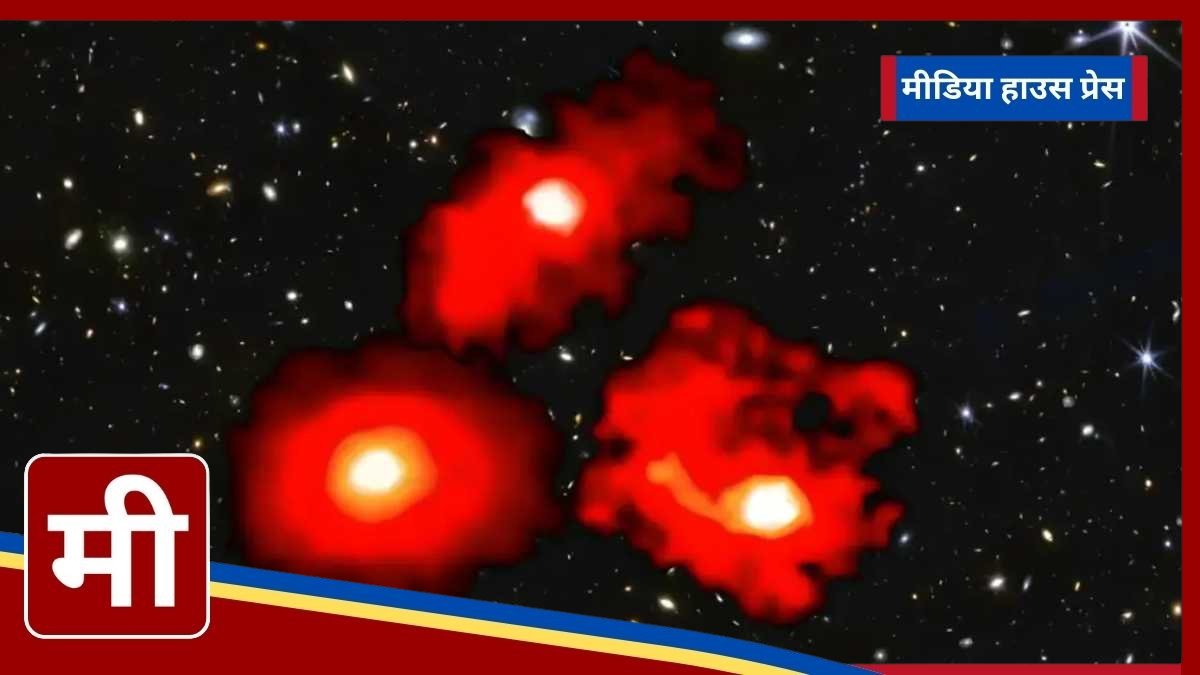James Webb Space Telescope Reveals Red Monsters — Enormous Galaxies Challenging Our Understanding of the Early Universe

The James Webb Space Telescope (JWST) has uncovered a stunning discovery that’s shaking up our understanding of galaxy formation. In a groundbreaking study, scientists identified three massive galaxies, dubbed “Red Monsters,” which existed just one billion years after the Big Bang. These galaxies, comparable in size to the Milky Way, defy traditional models of how galaxies evolve, raising new questions about the universe’s infancy.
A New Look at Galaxy Formation
For years, astronomers have believed that galaxy formation followed a gradual process. Gas and dust clumped together to form stars, and over billions of years, galaxies grew larger through mergers and collisions. However, the new findings from JWST challenge this conventional thinking. Instead of uncovering small, early galaxies, researchers have found fully formed, massive galaxies.
The extreme characteristics of these galaxies — their high mass and rapid star formation rates — suggest a different path for early galaxy growth. “The extreme properties of these galaxies are intrinsic to the galaxies themselves,” concluded the researchers, pushing scientists to rethink their models of cosmic evolution.
The Red Monsters and Their Surprising Features
This study, led by the University of Geneva (UNIGE), focused on 36 large, dusty, star-forming galaxies with redshift values between z = 5 and z = 9. These redshift values correspond to the universe’s first 1 to 1.5 billion years. Of these, three galaxies stood out for their remarkable size and rapid star formation rates.
The “Red Monsters” earned their name due to their red appearance in JWST images, a result of heavy cosmic dust. This dust absorbs short-wavelength light, scattering the remaining longer-wavelength light into red hues. Unlike the Hubble Space Telescope, which mainly captures optical light, JWST’s infrared technology allows it to peer through cosmic dust, revealing these distant and previously hidden galaxies.
These massive galaxies are forming stars two to three times faster than galaxies we see today. To achieve this rapid growth, the “Red Monsters” must convert up to 50% of their gas into stars — a stellar-mass conversion rate far higher than the typical 20% seen in most galaxies today.
No Supermassive Black Holes Here
Initially, researchers considered the possibility that active galactic nuclei (AGN), powered by supermassive black holes, might explain the brightness and massive size of these galaxies. AGNs can make galaxies appear brighter by emitting intense radiation as black holes consume matter. However, JWST’s data found no evidence of AGNs in the Red Monsters, suggesting that these galaxies’ size and luminosity come from their rapid star formation and abundant cosmic dust, not from supermassive black holes.
The Technology Behind the Discovery
The team used JWST’s FRESCO survey, which employs the Near Infrared Camera (NIRCam) and grism spectrograph. This powerful tool allows scientists to measure galaxy distances and stellar masses by analyzing light shifts due to the expanding universe. This technology enabled the team to accurately measure the size, mass, and star formation rates of these galaxies.
“The instrument on JWST allows us to study the growth of galaxies and how stellar mass accumulates throughout cosmic history,” said Pascal Oesch, principal investigator for the observation program at UNIGE.
A Mystery of Rapid Growth
One of the most puzzling aspects of these “Red Monsters” is how they grew so large so quickly. Traditional models of galaxy formation struggle to explain how these galaxies could accumulate such massive amounts of mass and form stars at such an accelerated rate. Researchers speculate that the early universe may have had more favorable conditions for rapid galaxy growth, such as an abundance of gas or more efficient cooling mechanisms. However, these theories are still unproven and require further observation to fully understand.
Implications for Cosmology
The discovery of the Red Monsters forces astronomers to reconsider long-held beliefs about the early universe. It suggests that galaxy formation may have occurred at a faster pace and with greater efficiency than previously thought. These findings challenge the traditional view of slow and steady galaxy growth and may open new doors for understanding the universe’s first epochs.
“As we study these galaxies in more depth, we hope to gain new insights into the conditions that shaped the universe’s earliest moments,” said Mengyuan Xiao, lead author of the study.
Looking Toward the Future
Future research using JWST and the Atacama Large Millimeter Array (ALMA) will offer further insights into the rapid growth of these ultramassive galaxies. Scientists plan to study a larger sample of similar galaxies to determine whether this accelerated growth was unique to the early universe.
The discovery of the Red Monsters is a turning point in cosmology, challenging existing models of galaxy formation and offering a glimpse into the universe’s infancy. With JWST’s groundbreaking capabilities, astronomers are now on the path to uncovering the secrets of the cosmos’ earliest moments. The findings could lead to transformative discoveries that will change our understanding of the universe for years to come.







